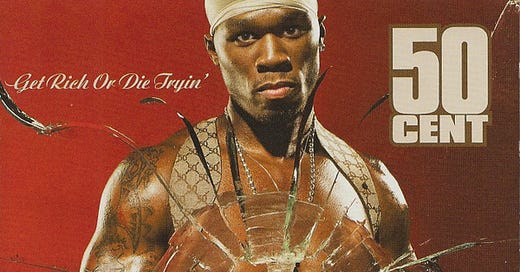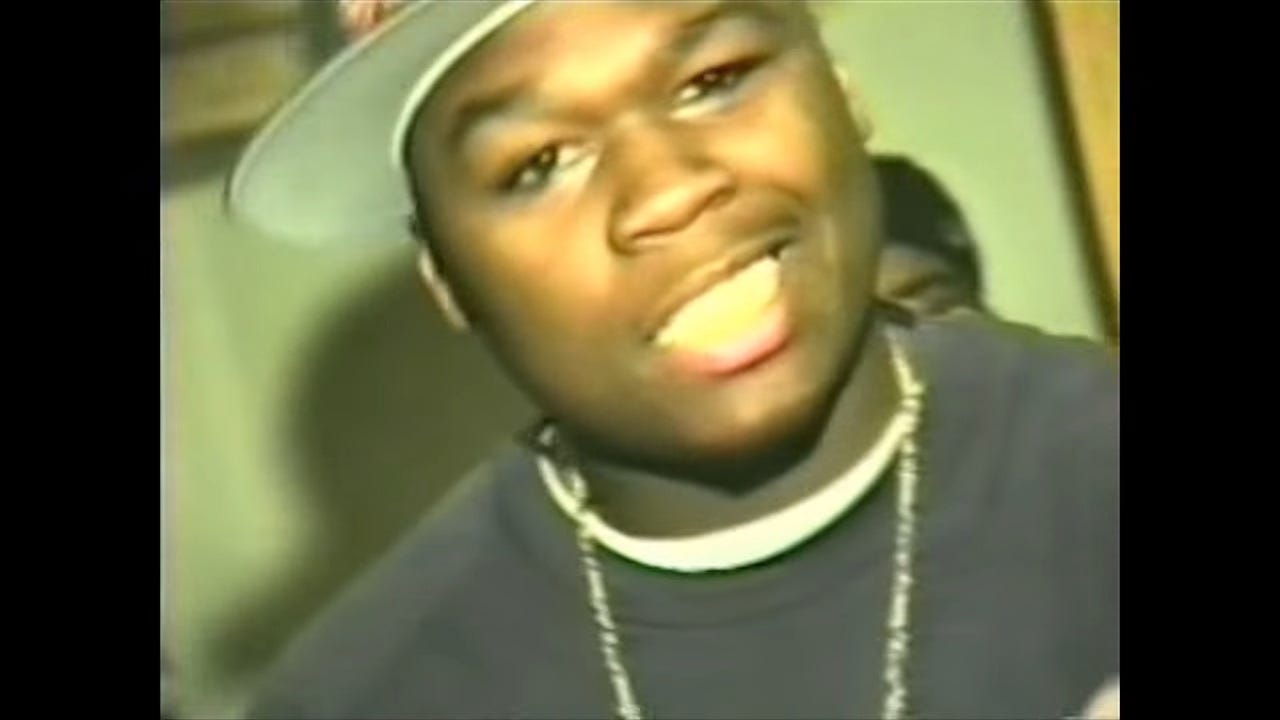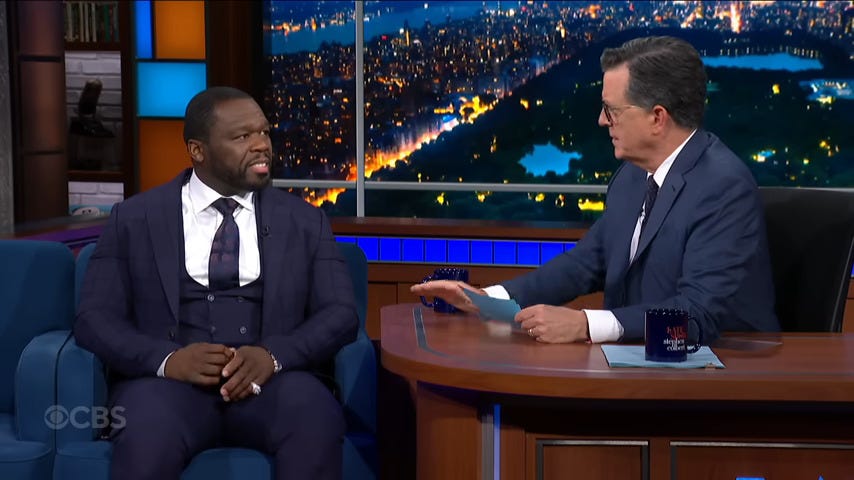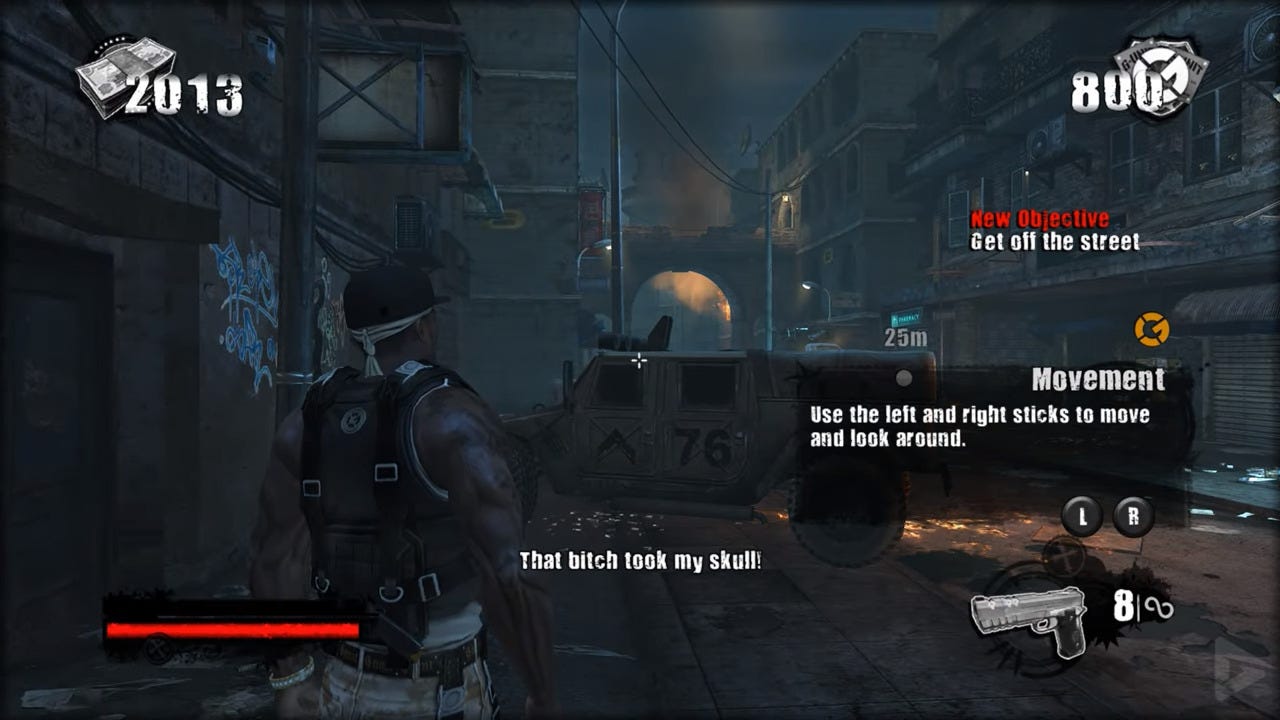82. 50 Cent - Get Rich or Die Tryin' (Interscope, Shady, 2003)
“If you shoot him, you'll just make him mad.” - The Waco Kid
It's 2003, and American culture is a torrent of psychopathy. Rush Limbaugh and Bill O'Reilly are taking Republican rhetoric to new lows, Britain is sending its most hateful hosts and judges to further poison US reality TV and Jack Bauer is teaching us the importance of enhanced interrogation techniques.
Hip-hop needed an ubermensch to fit the nation's mood, someone hewn from steel, who could show Ja Rule what time it is, teach Jay Z what a hard knock life looks like, give Nelly a wedgie and rip Eminem in half like a phone book. DMX might have fit the bill, but he was visibly using and had a media training gap. Fortunately for Eminem, he got to 50 Cent first. They quickly realised that they compensated for one another's deficiencies. 50 could benefit from induction into the mainstream and Eminem saw 50 as a useful way to bring what he and Dr Dre were doing back to street level after one too many novelty records.
50 Cent had been recording mixtapes non-stop since being stabbed and shot to pieces in 2000. He had a scrapped debut album in the can too. If ever a rapper needed to unleash, this was the moment. His survival may well have depended on it; some of 50's first financial excesses involved paying for police protection, and settling lawsuits. I said I was going to look at the rap sheets of the gangster rappers. 50 sold a lot of drugs for a very long time, he kept illegal weapons, his men robbed a lot of people, he got involved in [REDACTED, Bitcoin], made a viral video where he bullied an autistic teenager, and then there's the domestic violence and rape allegations, so far settled out of court. As with many on the Apple list, the Sean Combs trial will be of interest.
In all of his work, 50 Cent professes no love for women, not just echoing but parroting the words of Snoop Dogg a decade earlier. Shit like this gets less shocking and more depressing the more people you hear it from. He is of course coming at it from a different perspective. 50 Cent's style didn't change after he got shot. He sees himself as one of those powerful animals that psychopaths like. If he were an artwork, he'd be a Hirst. I'm thinking of the shark in formaldehyde but it seems that the diamond/platinum skull “For The Love Of God” has taken his fancy, given that he used it as the macguffin in his Xbox game 50 Cent: Blood On The Sand, famous for its repeated refrains of “That bitch has got my skull, and I want it back!”. When Get Rich or Die Tryin' dropped, he bought Mike Tyson's 50-room mansion. He hated it there, too big. He now professes to be living a life of total celibacy, in favour of a clear head and a better grip on his business empire. I don't see Snoop doing that, even as a joke.
50 Cent is amoral, but that's not enough for success. You need superficial charisma too, and in 2003, 50 Cent was a perfectly simple proposition: indestructible action man for the boys, cuddly teddy bear for the girls. Kind of a Mr T figure. I mention Mr T because there's something similar in the treatment he has received over the years, and I don't just mean weird appearances on The Simpsons. There is a kind of possessiveness, a desire to touch, especially by white people. Witness him on The Graham Norton show having his tongue palpated by Julie Walters (feeling for the shrapnel), or Stephen Colbert not being able to keep his hands off him. Simon Hattenstone interviewed him for the Guardian: “I ask what he is wearing today. “I don’t even have all my clothes on yet.” That’s exciting, I say, tell me more.”
Get Rich Or Die Tryin' is a fine showcase for 50's duality of drug-dealing mojo. “In Da Club” is its strongest ambassador, a “one for the fellas” song that is also a “one for the ladies” song. It frightened Jay Z when he heard it; he knew it would be a monster and ordered that the talent in his own stable release as much music as possible before it came out.
Across the album, everything is simple, at a low tempo, rarely above the 90 BPM mark. He is a deft mover in that range, his biggest strength being a lyrical timing that sounds very casual, but is pretty well irreplicable. The lyrics are a blunt instrument to bring audiences up to speed with his brutal life. You can tell when Eminem is ghost writing cause the syllable count goes above two. It's weighty, every track overdriven through the mixer, giving a soft distortion, a high-fidelity version of what you get on cheap mixtapes. Dre and Eminem are the main producers and they give it a NY feel, lots of minimalist epic classical stuff or three seconds of soul over the thickest bassy beats. There is shit-tonnes of gunfire which I have to say is an innovative form of exposure therapy for someone who has to have had PTSD at some point.
The blend works on this occasion. 'Wanksta', a portmanteau of either 'wannabe' or 'wack' and 'gangsta', having nothing to do with what the English get up to, puts an unnamed enemy in his place, delighting in their brokeness and fall from grace. “P.I.M.P” advertises his services as a pimp (which sound awful for all concerned). “High All The Time” is about him being high on weed all the time. Thing is he's not high most of the time and he's not a pimp, he's just pretending. Who's the wanksta now? Finally “21 Questions” is the sugar pill, acting as his version of “Sixteen Reasons” by Connie Stevens. It's a series of telling Hallmark cards to his sweetheart: “If I got locked up and sentenced to a quarter century / could I count on you to be there to support me mentally?”, “If I ain't rap 'cause I flip burgers at Burger King / Would you be ashamed to tell your friends you're feelin' me?”, “If a bitch took my skull and sold it to Iraqis / would you ride with G-Unit and get it back for me?”. The last one I made up.
Did It Make Much Of A Splash?
In the world of music 50 Cent didn't really last, his sales took a downward curve that he, more than 'the times', was responsible for. He didn't change his music cause his mind was elsewhere, and it showed. He was a titan in 2003, but he needed a worthy adversary for that to continue to mean anything. He crushed Ja Rule early, but after that, all his other beefs were pretty standard and tame. By the Obama years, creative and outré rap had made a mainstream comeback and 50 was barely on the map. Gangsta rap left him behind too, it all went trap on him. Nowadays, between novels, Curtis can be found on the screen. I looked at his last five films and they're all tax-break action movies where plays a supporting role uplifting a cancelled white man.
50 got trying, but he'll die rich. He capitalised on business momentum and for a while there quite a lot of people were wearing G-Unit tops, which amused me, cause the logos would always seem to crease into the c-word. Always ignore bankruptcy stories for the super-rich, no matter how reckless they might seem, it's just someone doing prudent accounting for them.
Where To Go From Here?
If you liked “Patiently Waiting” and want to hear him head-to-head with Eminem again, check “Gatman and Robbin’” from The Massacre, it's a rush.
There is a film version of Get Rich Or Die Tryin’. It has one of the funniest child-to-man transitions since Conan the Barbarian, where Curtis buys a gun then immediately ages fifteen years. It was directed by Jim Sheridan, who had two Daniel Day Lewis films under him, through gritted teeth. 50 apparently wouldn't stop throwing $100s around at every location, kinda fucks with the continuity.
50 Cent: Blood On The Sand is a uniquely odd videogame. Tear up an undisclosed location in the Middle East Tom Clancy-style at the height of the Iraq war looking for a stolen Hirst with DJ Whoo Kid and Tony Yayo. 50 had a seven-year-old son at the time who demanded that more helicopters be inserted into the game (the game, not The Game). 50 looked at the English production team and said "You heard him, more helicopters", adding a month or so to development.








